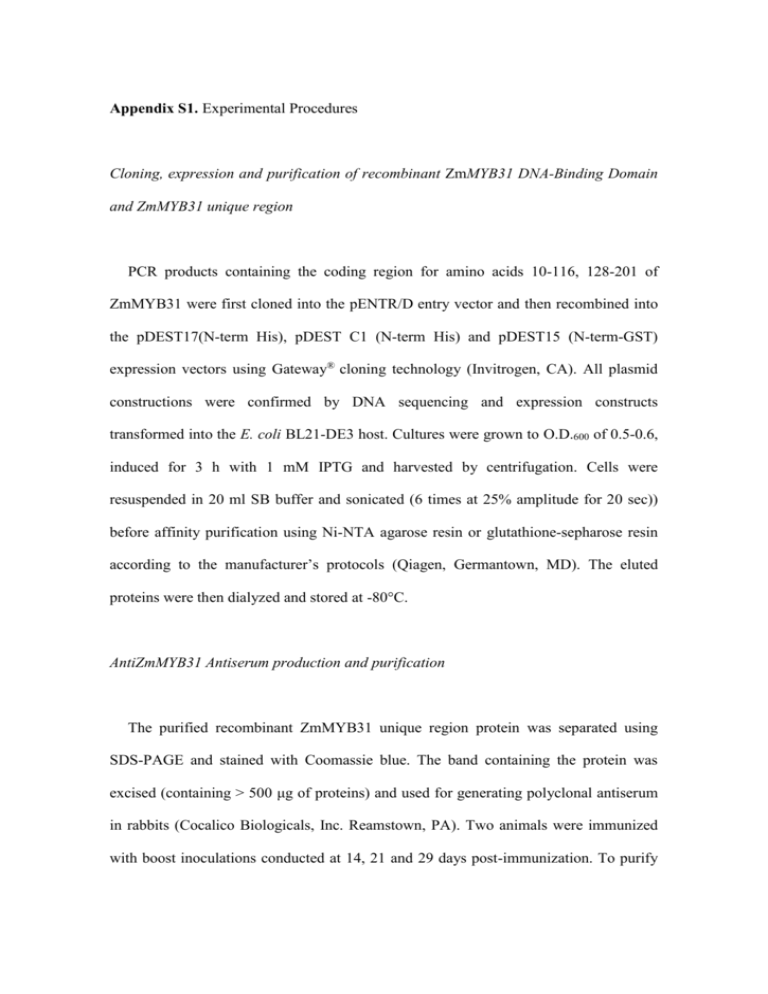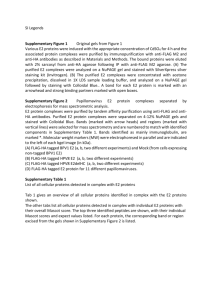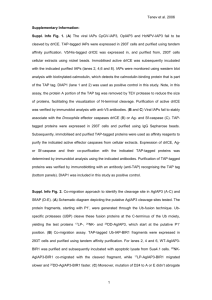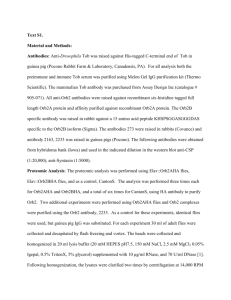TPJ_4363_sm_AppendixS1
advertisement

Appendix S1. Experimental Procedures Cloning, expression and purification of recombinant ZmMYB31 DNA-Binding Domain and ZmMYB31 unique region PCR products containing the coding region for amino acids 10-116, 128-201 of ZmMYB31 were first cloned into the pENTR/D entry vector and then recombined into the pDEST17(N-term His), pDEST C1 (N-term His) and pDEST15 (N-term-GST) expression vectors using Gateway® cloning technology (Invitrogen, CA). All plasmid constructions were confirmed by DNA sequencing and expression constructs transformed into the E. coli BL21-DE3 host. Cultures were grown to O.D.600 of 0.5-0.6, induced for 3 h with 1 mM IPTG and harvested by centrifugation. Cells were resuspended in 20 ml SB buffer and sonicated (6 times at 25% amplitude for 20 sec)) before affinity purification using Ni-NTA agarose resin or glutathione-sepharose resin according to the manufacturer’s protocols (Qiagen, Germantown, MD). The eluted proteins were then dialyzed and stored at -80°C. AntiZmMYB31 Antiserum production and purification The purified recombinant ZmMYB31 unique region protein was separated using SDS-PAGE and stained with Coomassie blue. The band containing the protein was excised (containing > 500 μg of proteins) and used for generating polyclonal antiserum in rabbits (Cocalico Biologicals, Inc. Reamstown, PA). Two animals were immunized with boost inoculations conducted at 14, 21 and 29 days post-immunization. To purify the antiserum raised against ZmMYB31, the same region used for antiserum generation was overexpressed in pDEST17 as a GST-fusion (GST-ZmMYB31 Unique). Polyclonal antibodies specific for ZmMYB31 were purified following the method of Bar-Peled and Raikhel (1996). The specificity of the purified antiserum was checked by western blot using purified 6xHIS or GST tagged proteins and total proteins from E.coli and maize. Approximately 50 ng of purified 6xHIS or GST tagged proteins and total proteins from E.coli and maize plant were separated by electrophoresis on a 15% SDS polyacrylamide gel and electro-transferred to PVDF membranes (BioRad). The membranes were probed with non-purified serum (1:2,000 dilution) and affinity-purified antiserum (1:200 dilution). Labelling DNA probes and electrophoretic mobility shift assays (EMSA) The synthetic oligonucleotides used were ACII, ACIII, MBS, ABP1, APB5. ABP1 contains the high affinity P1 binding site (haPBS) from the maize A1 gene promoter, and APB5, a mutated version in which the haPBS is destroyed (Grotewold et al., 1994). End labelling of synthetic oligonucleotide probes was carried out using T4Polynucleotide Kinase (Invitrogen) in the presence of a two-molar excess of 32P-dATP (>8,000Ci/mmol, GE Healthcare, Piscataway, NJ). The T4-Polynucleotide Kinase was then heat killed by boiling for 20 minutes, followed by dilution of the labelled oligonucleotides to a final volume of 50 µl in water. The labelled oligonucleotides were then annealed to an equi-molar amount of complementary oligonucleotides by heating to 95°C and cooling to room temperature. A fraction of the double-stranded labelled oligonucleotides was precipitated on glass filters for quantification by scintillation of the radiation incorporated. To precipitate the oligos, 2 µl of the oligo was pipetted onto the glass filters and allowed to dry. The filters were then added to ~25 mL of 10% TCA and 5 mM sodium phosphate buffer pH 7.5 and allowed to shake for 10 minutes at room temperature. Next, the filters were washed with ~25 mL of 95% ethanol while shaking for an additional 10 minutes at room temperature. Finally, a precipitated and nonprecipitated glass filter was quantified by scintillation. For EMSA, DNA-binding reactions were performed essentially as described (Grotewold et al., 1994) on ice for 30 minutes in a total of 25 µL with ~35 ng of purified protein in A-0 buffer (10 mM Tris pH7.5; 50 mM NaCl; 1 mM EDTA; 5% glycerol). The DNA-binding reactions also contained 0.8 µg of poly d(I)/d(C) and 1 mM dithiothreitol (DTT). After incubation on ice, 10,000 cpm of the oligonucleotide DNA probes were added to each reaction and allowed to incubate on ice for an additional 30 minutes. Protein-DNA complexes were resolved on a 8% polyacrylamide gels (80:1 acrylamide:bis-acrylamide) in 0.25X TBE (22.5 mM Tris-borate and 0.5 mM EDTA) running buffer at 415 V for 55 minutes at 4°C. The gels were then dried onto Whatman® filter paper and subjected to autoradiography at –70°C overnight or a Kodak phosphorimager for two hours and quantified using the BioRad imaging system (Hercules, CA). Chromatin immunoprecipitation (ChIP) experiments ChIP experiments were performed as described previously (Morohasi et al., 2007). Maize leaf sheath tissues (3 week old seedlings) were cross linked under vacuum for 15 min. Approximately 300 mg of tissue were ground for each immunoprecipitation. DNA was sheared by sonication to approximately 300 bp fragments using Biorupter at powder H for total 30 min. After preclearing with 40 µl of salmon sperm DNA/Protein A-agarose beads (Upstate Biotechnology) for 2 hrs at 4°C, immunoprecipitation was performed overnight at 4°C with either 2 µl of IgG, 5 µl of purified MYB31. After reverse cross-linking of the immunoprecipitated and Input DNA (set aside from the sonication step), the DNA was purified using the PCR Purification kit (Qiagen). HPLC-UV-ESI-MS/MS determination of sinapoylmalate and flavonoids Dry frozen leaves tissue from Arabidopsis thaliana (ca. 50 mg) were extracted with 5 mL of a mixture of MeOH/H2O (1:1 v/v) acidified with 0.8 % HCl 2N for 1h in an Intelli mixer RM-2L (Elmi, Riga, Latvia) at room temperature. The mixtures were centrifuged (3000g, 10 min), and the solid residue was extracted again with 2 mL of acetone/water (3:7) for 1 h and centrifuged. The two supernatants were combined, evaporated to dryness under a N2 stream, and diluted with 0.5 mL 0.1% formic acid in water. An Agilent series 1100 HPLC instrument (Agilent, Waldbronn, Germany) equipped with a quaternary pump, an UV detector, and autosampler was used for HPLC-UV-ESIMS/MS experiments. Separation was conducted on a Phenomenex Luna C18(2) (Torrance, CA, USA) 3.5 µm particle size column (50 x 2.1 mm i.d.) equipped with Phenomenex Securityguard C18 column (4x 3 mm i.d.). Flow rate was 400µl/min, the injection volume was 10 L and the separations were performed at 25 ºC. An API 3000 triple quadrupole mass spectrometer (PE Sciex, Concord, Ontario, Canada) equipped with a TurboIon spray source was used to obtain MS/MS data. Settings were the following: capillary voltage -3500 V (negative mode) or 5000 V (positive mode), nebulizer gas (N2) 10 arbitrary units (a.u.), curtain gas (N2) 12 a.u., collision gas (N2) 10 a.u., declustering potential -30 V, focusing potential -200 V, entrance potential 10 V, collision energy -30 V. The drying gas (N2) was heated to 400ºC and introduced at a flow rate of 8000cm3 min-1. Full-scan data acquisition was performed, scanning from m/z 100 to 1500 using a cycle time of 2 s with a step size of 0.1 units. Different HPLC procedures were used for the analysis of the polyphenols. For sinapoylmalate, a gradient elution was performed with a binary system consisting of: [A] 0.1% aqueous formic acid and [B] 0,1% formic acid in acetonitrile. An increasing linear gradient (v/v) of [B] was used, [t(min), %B]: 0,5; 30,23; 32,100; followed by a re-equilibration step. For anthocyanin analysis the gradient elution was carried out with in 5% formic acid in water [A] and 0.5% formic acid in acetonitrile [B] and the gradient (v/v) was [t(min), %B]: 0,10; 20,40; 21,100; also with a posterior re-equilibration step. Detection was carried out at 330 nm for sinapoylmalate, 265 nm for flavonols, and 520nm for anthocyanins. MS and MS/MS experiments were performed in negative mode for sinapoylmalate and in positive mode for anthocyanins. Protein extraction and 2D-PAGE Seeds of transgenic and wild-type A. thaliana were germinated onto solid Murashige and Skoog (MS) culture medium supplemented with 3% sucrose for one week. After germination, seedlings were transferred into 250 ml flasks containing 50 ml liquid MS medium supplemented with 3% sucrose (25 seedling/flask) and placed in a rotary shaker (130 rpm) at 22ºC under a 16/8 h light/dark cycle for three weeks. At the end of this culture period, roots from transgenic and control plants were collected, frozen in liquid nitrogen and stored at -80ºC until analysed. 0.6 g of proteins were treated and separated as previously described (Irar et al., 2006). 700 µg of total proteins were loaded onto non-linear (NL) pH 3-11, 18 cm immobilized pH gradient (IPG) strips (Immobiline DryStrips, Amersham Biosciences) for the first dimension. Bidimensional electrophoresis was performed according to Campo et al., (2004) and gels were stained with CBB G-250 (Bio-Rad). The experiment was repeated with two biological replicates and three experimental replicates for biological sample. To evaluate protein expression differences among gels, relative spot volume (% Vol.) was used. This is a normalized value and represents the ratio of a given spot volume to the sum of all spot volumes detected in the gel. Those spots showing a quantitative variation ≥ Ratio 1 were selected as differentially expressed. Statistically significant protein abundance variation was validated by Student’s t-Test (p<0.05). The selected differential spots were excised from the CBB G-250 stained gels and identified either by PMF using MALDI-TOF MS or by peptide sequencing at the Proteomics Platform (Barcelona Science Park, Barcelona, Spain). The MALDI-TOF MS analysis was performed according to Oliveira et al., (2007). REFERENCES Bar-Peled M and Raikhel NV. (1996). A method for isolation and purification of specific antibodies to a protein fused to the GST. Analyt. Biochem., 241, 140-142. Campo, S., Carrascal, M., Coca, M., Abián, J., San Segundo, B. (2004) The defense response of germinating maize embryos against fungal infection: a proteomics approach. Proteomics, 4, 383-396. Grotewold, E., Drummond, B.J., Bowen, B. and Peterson, T. (1994) The mybhomologous P gene controls phlobaphene pigmentation in maize floral organs by directly activating a flavonoid biosynthetic gene subset. Cell, 76, 543-53. Irar, S., Oliveira, E., Pagès, M., Goday, A. (2006) Towards the identification of lateembryogenic-abundant phosphoproteome in Arabidopsis by 2-DE and MS. Proteomics, 6, S175-S185. Oliveira, E., Amara, I., Bellido, D., Odena, M.A., Dominguez, E., Pagès., M and Goday, A. (2007) LC-MSMS identification of Arabidopsis thaliana heat-stable seed proteins: enriching for LEA-type proteins by acid treatment. J. Mass. Spectrom., 42, 1485-1495.








